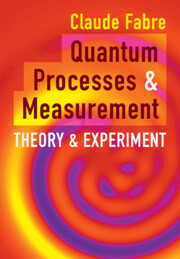Book contents
- Frontmatter
- Contents
- Introduction
- 1 Experiment: Detecting Single Quantum Objects
- 2 Description of Quantum Systems in Terms of the Density Matrix
- 3 Experiment: Quantum Processes
- 4 Evolution
- 5 Measurement
- 6 Experiment: Bipartite Systems
- 7 Entanglement
- 8 Experiment: Continuous Quantum Fluctuations
- 9 Continuous Variable Systems
- 10 Experiment: Parameter Estimation
- 11 Theory: Parameter Estimation
- A Basic Postulates of QuantumMechanics: a Reminder
- B Generalized Postulates of Quantum Mechanics
- C Description of Composite Systems
- D Qubits
- E Quantum Particle
- F Quantum Electromagnetic Field
- G Interaction between Light and Atoms
- H Interaction between Light Beams and Linear OpticalMedia
- I Interaction between Light Beams and Nonlinear OpticalMedia
- J Optomechanics
- K Basics of Circuit Quantum Electrodynamics
- References
- Index
9 - Continuous Variable Systems
Published online by Cambridge University Press: 27 July 2023
- Frontmatter
- Contents
- Introduction
- 1 Experiment: Detecting Single Quantum Objects
- 2 Description of Quantum Systems in Terms of the Density Matrix
- 3 Experiment: Quantum Processes
- 4 Evolution
- 5 Measurement
- 6 Experiment: Bipartite Systems
- 7 Entanglement
- 8 Experiment: Continuous Quantum Fluctuations
- 9 Continuous Variable Systems
- 10 Experiment: Parameter Estimation
- 11 Theory: Parameter Estimation
- A Basic Postulates of QuantumMechanics: a Reminder
- B Generalized Postulates of Quantum Mechanics
- C Description of Composite Systems
- D Qubits
- E Quantum Particle
- F Quantum Electromagnetic Field
- G Interaction between Light and Atoms
- H Interaction between Light Beams and Linear OpticalMedia
- I Interaction between Light Beams and Nonlinear OpticalMedia
- J Optomechanics
- K Basics of Circuit Quantum Electrodynamics
- References
- Index
Summary
Theoretical chapter devoted to the detailed description of continuous variable (CV) systems by consideringthe "phase space," that is spanned by position and momentum for massive particles, quadratures for a quantum electromagnetic field, and phase and charge for electrical circuits. It introduces tools like the Glauber, Husimi, or Dirac phase–space functions, and in more details the Wigner function, that are convenient to describe CV quantum states and their time evolution using the Moyal equation. The chapter gives examples of Wigner functions and their time evolution in the presence of dissipation. It then defines symplectic quantum maps that are simple and important cases of Hamiltonian evolution and are simply related to the covariance matrix containingvariances and correlations. It details the characterization of the quantum processes using the Williamson reduction and Bloch–Messiah decomposition. It discusses Gaussian and non-Gaussian states and the specific measurement procedures for CV states, such as homodyne and double homodyne detection. It introduces the EPR entangled state and, finally, describes how to characterize entanglement and unconditionally teleport Gaussian quantum states.
Keywords
- Type
- Chapter
- Information
- Quantum Processes and MeasurementTheory and Experiment, pp. 142 - 177Publisher: Cambridge University PressPrint publication year: 2023

